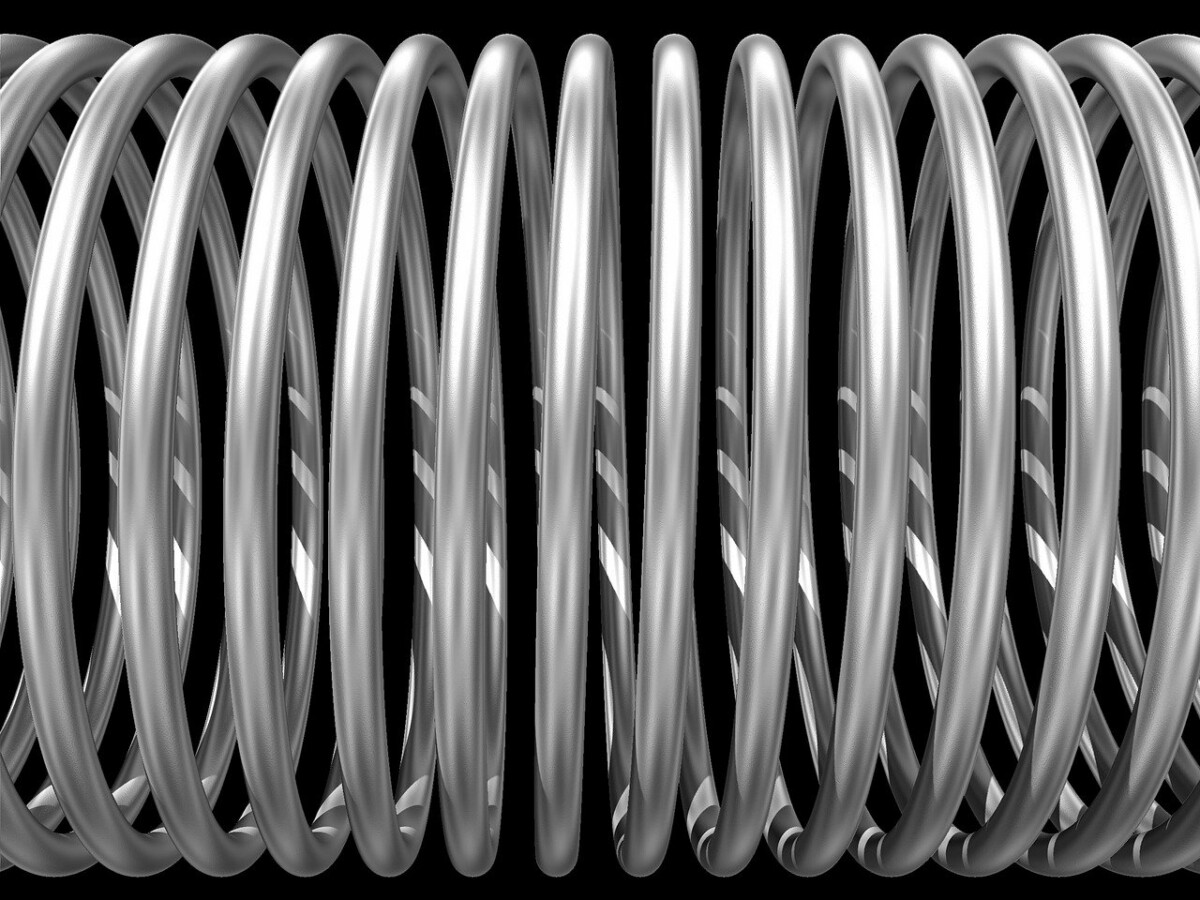Potential Energy in a Spring
Firstly, understanding the potential energy in a spring is fundamental to grasping how energy is stored and transferred in various physical systems. Springs, as elastic objects, are omnipresent in everyday life, from bungee chords to shock absorbers, and play a vital role in numerous applications. By examining potential energy in a spring, key principles such as Hooke’s Law, equilibrium positions, and conservative forces become clearer. Thus this article delves into the complex concepts surrounding spring potential energy, aiming to elucidate the science behind it.
What is Potential Energy in a Spring?
Potential energy in a spring refers to the energy stored within the spring as a result of its deformation. This deformation could either be a stretch or a compression from its equilibrium position. When a spring is displaced from its natural state, it gains potential energy by virtue of its position.
Watch the video below for a comprehensive explanation
Hooke’s Law and Spring Force
Hooke’s Law is central to understanding the potential energy in a spring. In fact according to Hooke’s Law, the force required to stretch or compress a spring by a distance xxx is directly proportional to that distance. This relationship is represented by the following equation: F=−kxF = -kxF=−kx where:
- FFF is the restoring force exerted by the spring,
- kkk is the spring constant, and
- xxx is the displacement from the equilibrium position.
Spring Constant and Equilibrium Position
The spring constant kkk is a measure of the stiffness of the spring and varies between different springs. Therefore a higher value of the spring constant indicates a stiffer spring. The equilibrium position is the point at which the spring is neither stretched nor compressed, meaning it is in its natural state.
Calculation of Potential Energy in a Spring
The potential energy of a spring is given by the formula: PE=12kx2PE = \frac{1}{2} k x^2PE=21kx2 This potential energy formula shows that the energy stored in the spring is proportional to the square of the displacement xxx.
Consequently, more stored energy is seen with greater displacement from the equilibrium position.
Elastic Limit and Restorative Force
Springs and other elastic materials have an elastic limit, beyond which they do not return to their normal shape. So within this limit, the restorative force acts to bring the spring back to its original shape, storing potential energy in the process. Moreover if the spring deviates from this limit, it might deform permanently.
Real-World Applications
In many practical applications, the potential energy in a spring is harnessed to perform useful work. For instance:
- Shock Absorbers: Utilize springs to absorb and dissipate energy from shocks, enhancing comfort and safety in vehicles.
- Regenerative Braking Systems: Convert the kinetic energy of a moving vehicle into potential energy stored in springs or other elastic components, improving energy efficiency.
- Bungee Chords: Use the potential energy in the stretched spring to create thrilling experiences while ensuring safety.

Potential Energy in a Spring FAQs
What is the potential energy in a spring?
The potential energy in a spring is the energy stored due to its deformation from the equilibrium position.
How does Hooke’s Law relate to potential energy in a spring?
Hooke’s Law states that the force needed to deform a spring is proportional to the displacement, which directly affects the potential energy stored.
What factors influence the potential energy of a spring?
The spring constant and the displacement from the equilibrium position are key factors influencing the potential energy.
Can all springs store the same amount of potential energy?
No, the potential energy stored depends on the material of the spring and its specific spring constant.
What happens if a spring exceeds its elastic limit?
If a spring exceeds its elastic limit, it may not return to its original shape, leading to permanent deformation and loss of elastic properties.
How is the potential energy formula derived?
The potential energy formula PE=12kx2PE = \frac{1}{2} k x^2PE=21kx2 is derived from integrating the force applied over the distance of displacement.
In summary, potential energy in a spring is a crucial concept in understanding energy storage and transfer in various systems. By adhering to principles such as Hooke’s Law and recognizing the role of equilibrium positions and spring constants, the science behind spring potential energy becomes clearer.
The Dynamics of Spring Potential Energy
Understanding the dynamics of potential energy in a spring involves exploring how energy transformations occur within the system. Indeed this energy conversion is pivotal in various mechanical and structural applications.
In such systems, the interplay between potential energy and kinetic energy showcases the conservation of mechanical energy.
Potential Energy and Kinetic Energy
Potential energy in a spring transforms into kinetic energy when the spring is released from its stretched or compressed state. The total energy in the system remains constant, adhering to the principle of conservation of mechanical energy.
This relationship is often analyzed through the following equation: KE+PE=constantKE + PE = \text{constant}KE+PE=constant where:
- KEKEKE is the kinetic energy,
- PEPEPE is the potential energy.
When a spring is compressed or stretched, it stores potential energy. Hence upon release, this energy converts into kinetic energy as the spring returns to its equilibrium position. Furthermore at the equilibrium point, the kinetic energy is at its maximum, and the potential energy is zero.
Displacement and Spring Potential Energy
The displacement of the spring (xxx) from its equilibrium position directly affects the amount of potential energy stored. As displacement increases, the potential energy of the spring also increases, following the quadratic relationship described in the potential energy formula.
Displacement Graph
A displacement graph effectively illustrates the relationship between the potential energy and the displacement of the spring.
On this graph, the potential energy is plotted on the y-axis, and the displacement xxx is plotted on the x-axis. The graph typically shows a parabolic curve, indicating the quadratic dependence of potential energy on displacement.
Conservative Forces and Potential Energy
Springs are governed by conservative forces, meaning the work done by these forces is path-independent and depends only on the initial and final positions.
characteristic is crucial for the predictable behavior of potential energy in a spring. Conservative forces ensure that energy can be efficiently stored and retrieved without loss, making springs ideal for various applications.
Energy Storage and Mechanical Systems

Springs serve as vital components in numerous mechanical systems due to their ability to store and release energy efficiently. Examples of such systems include:
- Clocks and Watches: Springs store energy that drives the mechanical movement of clocks and watches, ensuring precise timekeeping.
- Mattresses and Cushions: Springs in these items store potential energy to provide comfort and support, returning to their original shape after compression.
- Vehicles: Suspension systems in vehicles use springs to absorb shocks and maintain a smooth ride, storing and releasing energy with each bump.
Factors Affecting Spring Potential Energy
Several factors influence the potential energy stored in a spring:
- Spring Constant (k): A higher spring constant means a stiffer spring, resulting in greater potential energy for the same displacement.
- Displacement (x): Greater displacement from the equilibrium position results in more potential energy.
- Material of the Spring: Different materials have varying elastic properties, affecting the spring constant and the potential energy storage capacity.
- Elastic Limit: Staying within the elastic limit ensures that the spring can return to its original shape and repeatedly store potential energy.
Potential Energy in Real-World Applications
In practical applications, the potential energy of a spring is harnessed for various purposes. For instance:
- Industrial Machines: Springs are used in machines to absorb and release energy, improving efficiency and performance.
- Toys: Many toys, such as wind-up cars and jumping frogs, utilize spring potential energy to create movement and entertainment.
- Medical Devices: Springs in medical devices, such as syringes and pumps, ensure precise control and functionality by storing and releasing energy.
Potential Energy in a Spring FAQs Continued
How does the spring constant affect potential energy?
The spring constant determines the stiffness of the spring. A stiffer spring (higher spring constant) will store more potential energy for a given displacement.
Can potential energy in a spring be negative?
Potential energy in a spring cannot be negative because it is defined as the energy stored due to deformation. The quadratic relationship in the potential energy formula ensures positive values.
What is the equilibrium position of a spring?
The equilibrium position is the natural state where the spring is neither stretched nor compressed. At this point, potential energy is zero, and kinetic energy can be at its maximum if the spring is in motion.
Why are springs considered elastic objects?
Springs are considered elastic because they can return to their original shape after being deformed. This property allows them to store and release potential energy efficiently.
How is potential energy in a spring different from gravitational potential energy?
Potential energy in a spring depends on the displacement from the equilibrium position and the spring constant, whereas gravitational potential energy depends on the height and mass of an object in a gravitational field.
In conclusion, the dynamics of potential energy in a spring are integral to understanding energy transformations and mechanical efficiency in various applications.
By examining the factors that influence potential energy and recognizing the practical uses of springs, the significance of this form of energy becomes evident.
Mathematical Analysis of Spring Potential Energy
The mathematical equations governing potential energy in a spring provide a deeper understanding of its behavior under different conditions. By exploring these equations, one can predict how a spring will respond to various forces and displacements.
Potential Energy Formula
The fundamental formula for the potential energy in a spring is: PE=12kx2PE = \frac{1}{2} k x^2PE=21kx2 Here, PEPEPE represents the potential energy, kkk is the spring constant, and xxx is the displacement from the equilibrium position.
This equation highlights that potential energy is directly proportional to the square of the displacement and the spring constant.
Deriving the Potential Energy Formula
The derivation of the potential energy formula starts with the concept of work done on the spring. Work is defined as the product of force and displacement. For a spring, the force is given by Hooke’s Law: F=−kxF = -kxF=−kx
To calculate the work done, the force is integrated over the displacement: W=∫0xF dx=∫0x(−kx) dxW = \int_0^x F \, dx = \int_0^x (-kx) \, dxW=∫0xFdx=∫0x(−kx)dx W=−12kx2W = -\frac{1}{2}kx^2W=−21kx2
Since the work done on the spring is stored as potential energy, we have: PE=12kx2PE = \frac{1}{2}kx^2PE=21kx2
Practical Implications of Potential Energy in a Spring
Energy Conservation in Mechanical Systems
Springs are essential in mechanical systems where energy conservation is critical. For example, in shock absorbers, the spring’s potential energy absorbs the kinetic energy of a moving vehicle, transforming it into heat or storing it for later use. This energy transformation ensures the vehicle maintains stability and comfort.
Restoring Force and Equilibrium
The restoring force in a spring acts to return the spring to its equilibrium position. This force is proportional to the displacement, as described by Hooke’s Law. When the spring is stretched or compressed, it exerts a force in the opposite direction to the displacement, facilitating the return to equilibrium.
Analyzing Spring Systems
Series and Parallel Springs
Springs can be arranged in series or parallel, affecting their overall spring constant and potential energy storage capacity. In a series arrangement, the total spring constant decreases, whereas, in a parallel arrangement, the spring constant increases.
For springs in series: 1ktotal=1k1+1k2+…+1kn\frac{1}{k_{\text{total}}} = \frac{1}{k_1} + \frac{1}{k_2} + \ldots + \frac{1}{k_n}ktotal1=k11+k21+…+kn1
For springs in parallel: ktotal=k1+k2+…+knk_{\text{total}} = k_1 + k_2 + \ldots + k_nktotal=k1+k2+…+kn
Real-World Examples and Applications

Springs are utilized in various everyday objects and advanced technological systems due to their energy storage capabilities.
Bungee Jumping
In bungee jumping, the potential energy in the stretched spring (bungee cord) is transformed into kinetic energy as the jumper falls. At the lowest point of the jump, the potential energy is at its maximum, providing a thrilling and safe experience.
Regenerative Braking Systems
Regenerative braking systems in electric vehicles use springs to store kinetic energy during braking. This energy is then converted back into electrical energy, improving overall energy efficiency and reducing wear on brake components.
Potential Energy in a Spring Frequently Asked Questions (Continued)
How do springs store and release energy?
Springs store energy when they are stretched or compressed from their equilibrium position. This energy is released as the spring returns to its equilibrium state, transforming potential energy into kinetic energy.
What is the significance of the spring constant kkk?
The spring constant kkk determines the stiffness of the spring. A higher spring constant indicates a stiffer spring, which stores more potential energy for a given displacement.
How does the material of the spring affect its behavior?
The material of the spring affects its elasticity and spring constant. Different materials can withstand varying degrees of deformation before reaching their elastic limit, influencing the spring’s potential energy storage capacity.
What role do springs play in mechanical watches?
In mechanical watches, springs store potential energy when wound. This energy is gradually released to power the movement of the watch, ensuring accurate timekeeping.
Can the potential energy in a spring be used for energy storage in renewable energy systems?
Yes, potential energy in springs can be harnessed for energy storage in renewable energy systems. Springs can store energy generated from renewable sources, such as wind or solar power, for later use.
Potential Energy in a Spring Conclusion
The mathematical analysis and practical implications of potential energy in a spring reveal its vital role in various mechanical and technological systems.
By understanding the equations governing spring behavior and exploring real-world applications, the significance of potential energy in springs becomes evident.
From everyday objects to advanced engineering solutions, springs provide efficient energy storage and transfer, showcasing the elegance of this fundamental physical principle.
Advanced Concepts in Spring Potential Energy
Elastic Limit and Beyond
The elastic limit of a spring is the maximum extent to which it can be stretched or compressed without permanently deforming. Hence beyond this limit, the material of the spring may not return to its original shape, leading to a loss of its elastic properties. Understanding the elastic limit is crucial for applications requiring repeated and reliable performance of springs.
Stress-Strain Relationship
The stress-strain relationship in elastic materials, including springs, provides insights into their mechanical properties. Stress refers to the force applied per unit area, while strain is the deformation experienced by the material.
Hooke’s Law can be extended to describe this relationship: Stress=Young’s Modulus×Strain\text{Stress} = \text{Young’s Modulus} \times \text{Strain}Stress=Young’s Modulus×Strain Young’s Modulus is a measure of the stiffness of the material, analogous to the spring constant for springs.
Energy Dissipation and Damping
In real-world applications, springs often experience energy dissipation through damping. Damping is the process by which mechanical energy is converted into thermal energy, usually due to frictional forces within the material. This energy loss can affect the performance and efficiency of systems utilizing springs.
Types of Damping
- Viscous Damping: Common in systems where a fluid medium is involved, such as shock absorbers in vehicles.
- Coulomb Damping: Results from friction between contacting surfaces.
- Structural Damping: Inherent in the material of the spring, caused by internal friction.
Practical Applications of Potential Energy in Springs
Inclined Planes and Simple Machines
Springs are often used in conjunction with inclined planes and other simple machines to amplify forces and facilitate movement. For instance, a spring-loaded ramp can store potential energy when compressed, releasing it to assist in moving objects upward with less force.
Conservation of Mechanical Energy
Springs play a critical role in systems that adhere to the conservation of mechanical energy. In such systems, potential energy, kinetic energy, and sometimes gravitational potential energy interchange without loss. A classic example is the pendulum, where the spring potential energy and gravitational potential energy interchange, maintaining constant total energy.
Potential Energy in Elastic Objects
Elastic objects like rubber bands and metal springs exhibit potential energy when deformed. These objects can store significant amounts of energy, which is utilized in various innovative applications.
Rubber Bands and Bungee Cords
Rubber bands store potential energy when stretched. This energy is utilized in various applications, from simple stationary items like paper holders to more complex uses in bungee cords. Bungee cords, specifically, store massive amounts of potential energy, ensuring safe and controlled energy release in activities like bungee jumping.
Potential Energy in Technological Innovations
Modern technological advancements harness the potential energy in springs for improved performance and efficiency.
Periodic Motion Systems
Systems involving periodic motion, such as oscillating masses and pendulums, rely heavily on springs. The potential energy stored in these springs ensures sustained oscillations, essential for timekeeping devices and certain types of engines.
Regenerative Braking Systems
In regenerative braking systems, springs play a pivotal role by storing kinetic energy during braking. This stored energy can later be converted back into electrical energy, enhancing the overall energy efficiency of electric and hybrid vehicles.
Potential Energy in a Spring FAQs (Final Section)
How do springs contribute to the functionality of regenerative braking systems?
Springs in regenerative braking systems store kinetic energy during braking. This stored energy can then be converted back into electrical energy, improving the efficiency and longevity of the braking system.
What happens when a spring exceeds its elastic limit?
When a spring exceeds its elastic limit, it undergoes permanent deformation, losing its ability to return to its original shape and, consequently, its ability to store potential energy efficiently.
Can different materials affect the potential energy stored in a spring?
Yes, different materials have varying elastic properties, affecting the spring constant and the amount of potential energy that can be stored. For example, metal springs typically store more potential energy than rubber bands due to their higher stiffness.
Potential Energy in a Spring Conclusion
Finally, potential energy in a spring is a fascinating and essential concept in physics and engineering, underpinning numerous applications and innovations.
By understanding the principles of Hooke’s Law, the behavior of elastic materials, and the dynamics of energy transformation, one gains a comprehensive view of how springs function and contribute to various systems.
Springs not only demonstrate fundamental physical principles but also embody the ingenuity of human design and engineering. So from simple toys to sophisticated mechanical systems, the potential energy in springs continues to play a crucial role in enhancing functionality, efficiency, and innovation across diverse fields.
Through ongoing research and technological advancements, the applications of spring potential energy are bound to expand, further highlighting its significance in both everyday life and advanced scientific endeavors.
Recent Posts
Understanding Energy and Electricity: The Power For Progress
Energy and Electricity Energy and electricity are integral components of modern life, powering everything from homes and businesses to transportation and communication. Without them, the...
The Future of Wind Energy The future of wind energy is set to play a critical role in addressing global energy needs while combating climate change. As renewable energy sources like wind and...


